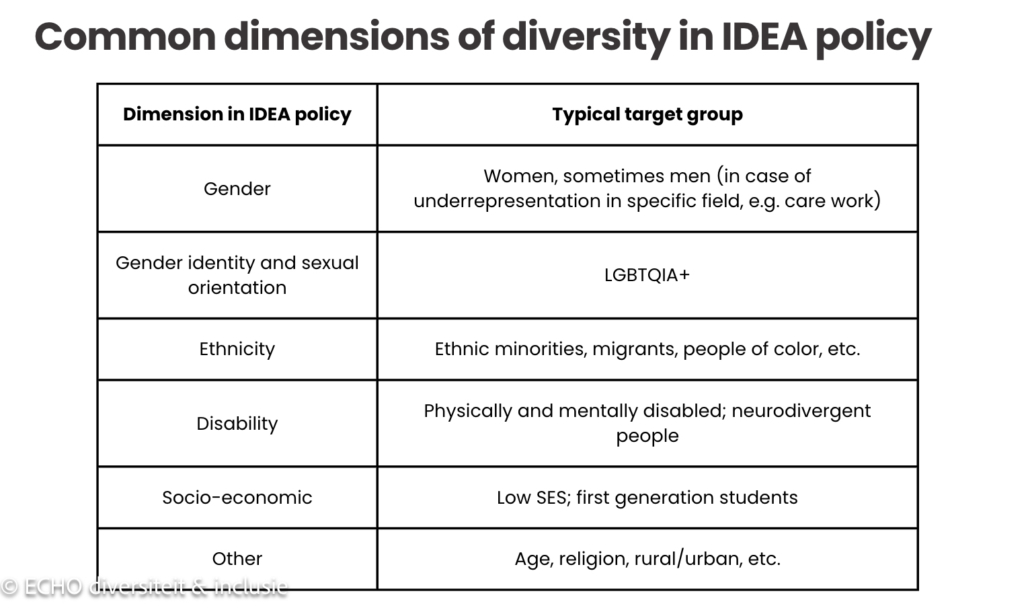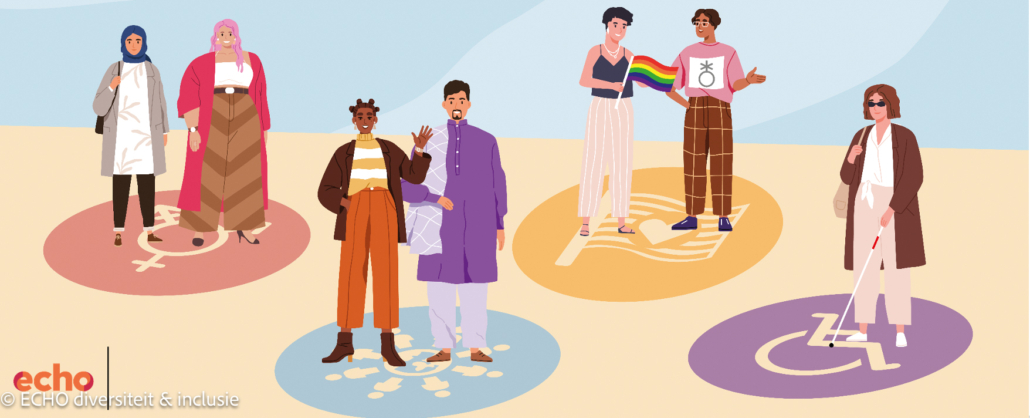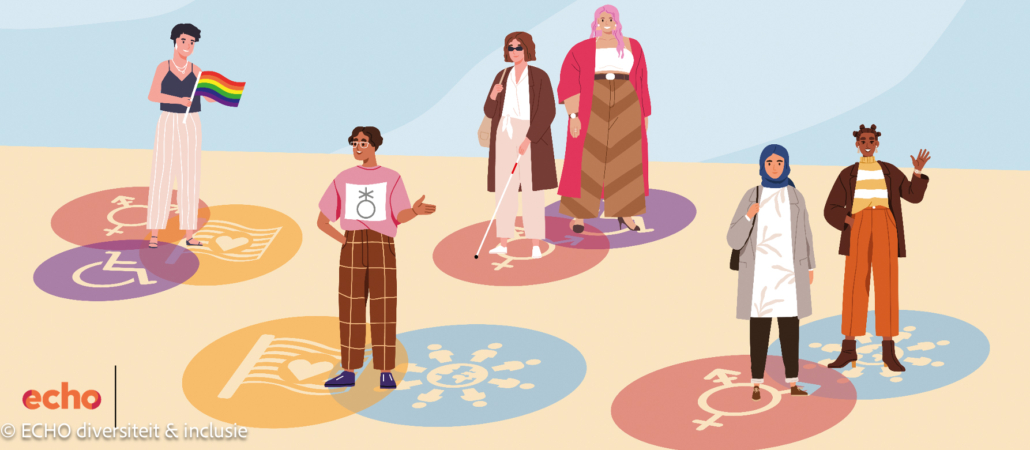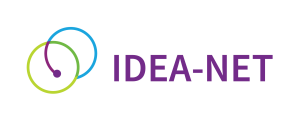IDEA stands for Inclusion, Diversity, Equity, and Access. These concepts are interconnected, but each addresses different parts of the system that can produce inequity in higher education.
Access and Diversity focus on the front door— who gets the opportunity to enter the university.
- Access is about removing barriers so that people from all backgrounds (regardless of income, race, disability, gender, or other identity factors) can apply and be admitted.
- Diversity refers to the presence of a wide range of people with different identities and experiences within the university community.
To have a truly diverse university, access must be equitable. That’s why outreach, recruitment, admissions, and hiring practices all play a key role in shaping both access and diversity.
Inclusion is about what happens after people are in. It asks: Do all students and staff feel respected, valued, and supported to succeed?
- Inclusion ensures that people don’t just enter the institution but also that there is (student/staff) retention. For this to happen, people need to feel a sense of belonging and have equal opportunities to participate and thrive.
- Safety, in some contexts, is also part of inclusion. It refers to creating environments free from harm, discrimination, or exclusion.
This includes things like inclusive curricula, culturally responsive teaching, support services, and policies that protect against discrimination and harassment.
Equity goes a step further. It recognizes that not everyone starts from the same place, and so simply treating everyone the same is not enough.
- Equity means recognizing that the system is inequitable and giving each person what they need to succeed— whether that’s academic support, accessible resources, or adjustments to ensure fair treatment and outcomes.
An equity-minded approach can also be denoted as a color brave approach, as opposed to a color blind approach (figure 1).
- A color brave approach acknowledges that the playing field is not level and that specific interventions for specific groups are needed to create equal opportunities for all. The color brave approach views inequity as an institutional problem.
- A color blind approach does not acknowledge these inequities inherent in the system and applies the same, generic approach to everyone, based on the principles of equality rather than equity. The color blind approach views inequity as an individualized problem.

Social justice relates to but extends beyond inclusion, diversity, equity, and access, by actively seeking to transform the systems that produce and sustain inequality.
- While IDEA efforts often focus on improving access, inclusion and representation within existing structures, social justice aims to dismantle and rebuild those structures to address root causes of inequity. This approach involves challenging institutional norms, redistributing power, and implementing policies that rectify historical and systemic injustices.
- If we relate it back to the metaphorical fence (figure 1), achieving social justice would mean that the barriers leading to unequal outcomes have been taken away altogether (figure 2).
In higher education, this means not only opening doors but also reimagining curricula, governance, and campus culture to foster true equity and belonging.

Which specific groups are the focus of IDEA interventions depends on national, social, historical, and political contexts.
In general, the following dimensions of diversity are commonly included in IDEA policies across institutions: gender, gender identity and sexual orientation, ethnicity, disability, socio-economic background, and others (see figure 3).
The exact target groups may differ by context, but they typically include communities that have been historically marginalized and have organized to fight for equal rights— such as through the women’s movement, LGBTQ+ rights movement, anti-racism efforts, disability rights activism, and more.
It’s important to note that these categories are not fixed or universally agreed upon. For example, gender and gender identity are not always treated as separate categories in policy. The list here reflects the groupings most commonly found in institutional frameworks, not necessarily the only or ‘correct’ ones.

However, by categorizing differences we do not always acknowledge that there is overlap between these groups. No one embodies just one dimension of diversity. Figure 4 and 5 show the difference between looking at diversity in a one-dimensional way versus looking at it through an intersectional lens.
In figure 4, you see a one-dimensional view— maybe focusing on just one aspect, such as gender or ethnicity. This kind of approach tends to overlook the diversity within groups; it runs the risk of treating people as if they all have the same experience just because they share one identity.
But in figure 5, you see an intersectional view. This recognises that people don’t fit into neat boxes. Someone can be, for example, a queer Muslim woman with a disability— and each of those aspects interacts with the others in shaping her experience.


Thus intersectionality, a term coined by Kimberlé Crenshaw in 1989, is really about how different parts of who we are (like our background, gender, skin colour, religion, disability, or sexuality) come together and shape our experiences in life.
- Layered identities & specific experiences: We all have layered identities, and sometimes these layers can lead to overlapping challenges. For example, someone might face barriers not just because they’re a woman, but also because they’re a woman with a migrant background. That specific combination creates a unique experience.
- Societal context: It’s important to remember that these experiences don’t happen in a vacuum. They’re shaped by bigger things going on in society, like racism, sexism, or discrimination in education or the workplace. These aren’t just personal problems— they’re structural issues that affect how people are treated.
Intersectionality helps us see the full picture. It reminds us that people’s experiences of exclusion or unfairness are complex, and we have to take all of these layers into account when working on IDEA.
For who: A group of students or staff with little or varying levels of experience with IDEA-topics.
When: During a workshop or class. Use this activity at the start of a session on IDEA Concepts as a conversation starter, to get people to engage with the material immediately. After this activity, you can use the information, resources and slides of this module to further explain the concepts.
Activity:
1. Designate one corner of the room as “Diversity” (e.g. the left side of the room), another corner as “Inclusion” (e.g. the right side of the room), and another as “Exclusion” (e.g. the back of the room).
2. Show a statement on the slide (see pre-made slides), such as:
- Our university/faculty should be a reflection of society
- I don’t see difference, because everyone is equal to me
3. Invite participants to, if they are able to do so, walk over to the concept which they think best matches the statement on the slide. Ask them: “do you think the statement is about Diversity, Inclusion or Exclusion?”
4. Once everyone is in position, discuss the different interpretations (max. 15 min. per statement). As a facilitator, make sure:
- That several people from every ‘group’ (Diversity, Inclusion and Exclusion) get to speak and explain why they chose to stand there. Allow other participants to respond.
- That participants stay on topic: the point is not for participants to go into why they agree or disagree with the statement, but why they think it relates to diversity, inclusion or exclusion. The point is to start to give different definitions/perspectives to these concepts.
- To clarify that there is no right or wrong answer. The point is to discuss how these statements can be interpreted differently and how these seemingly simple concepts can have different meanings from different perspectives.
5. After 15 minutes, move on to the next slide/statement. Repeat.
Teaching Learning Center (n.d.). Begrippenlijst [Concept list]. https://www.tlcenter.nl/begrippenlijst/
Ahmed, S. (2012). On being included: Racism and diversity in institutional life. Duke University Press.
Crenshaw, K. (1989). “Demarginalizing the Intersection of Race and Sex: A Black Feminist Critique of Antidiscrimination Doctrine, Feminist Theory and Antiracist Politics,” University of Chicago Legal Forum: Vol. 1989: Iss. 1, Article 8.
IDEA-net Guidelines Toolkit for setting up an IDEA office https://idea-net.eu/guideline-toolkit/
Erasmus University (EUR) Inclusive HR Toolkit for inclusive selection & recruitment https://www.eur.nl/en/media/2021-04-engbrochurewstoolkit21112018en
IDEA-net database – examples of worldwide IDEA offices and initiatives https://idea-net.eu/idea-net-cases/
MultInclude – database and analysis of 70+ evidence based practices to promote inclusion in higher education https://multinclude.eu/

